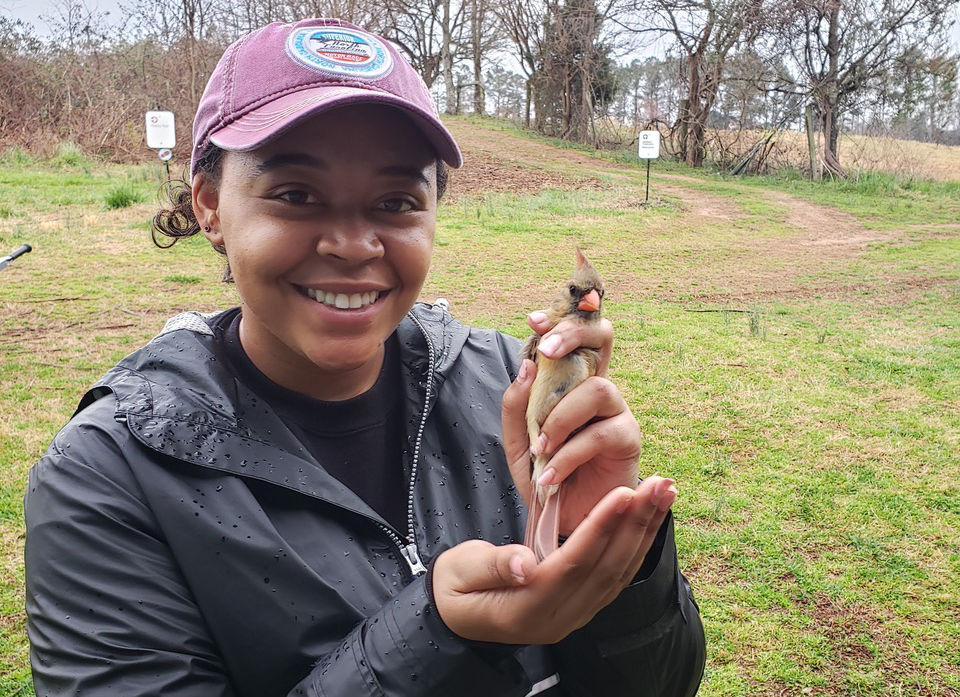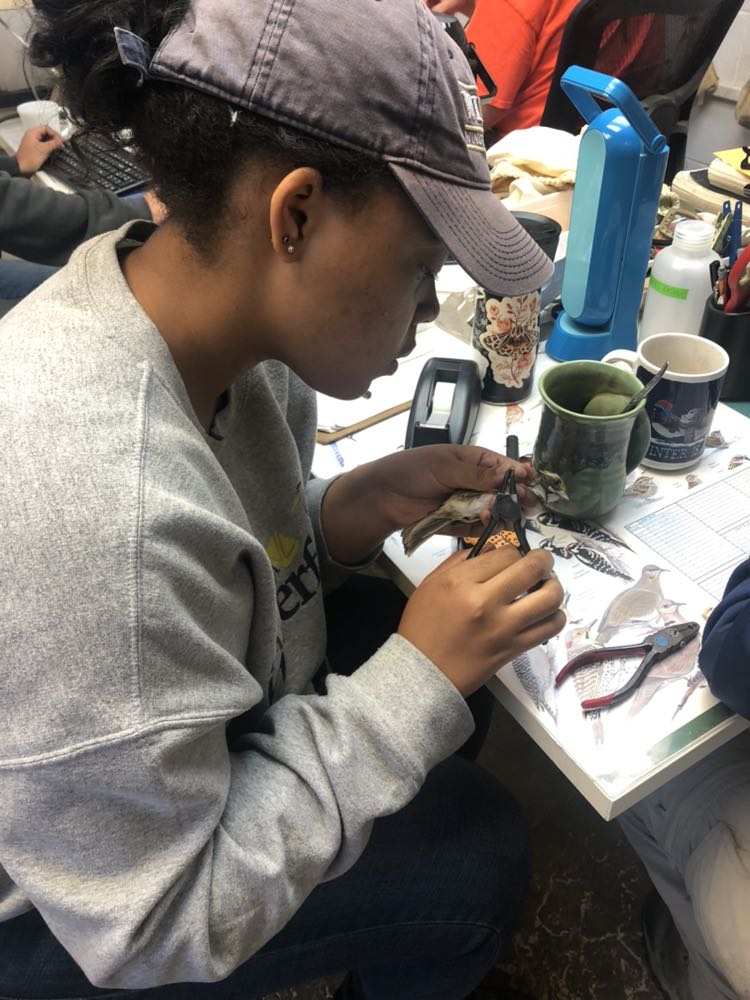
Lauren D. Pharr holding a female Northern Cardinal (Cardinalis cardinalis) captured, banded, and later released in Raleigh, North Carolina.
What Can Trees Do For Birds (and Birds Do For Trees)?
By Lauren D. Pharr
I am an ornithologist and a current graduate research assistant at North Carolina State University in Raleigh, North Carolina. I am also a science communicator who loves to share my passion for birds with others.
There are many ways to experience and value nature, and one is to interact and engage with nature personally. Birding, and nature in general, brings me peace and joy. As a researcher, I get to enjoy an even closer and more personal involvement with birds. I study whether temperature and human-influenced climate change as well as urban noise and light affect birds’ nesting behavior. So I have the satisfaction of knowing that my work directly contributes to bird survival and climate knowledge. As a scientist and researcher, I also participate in bird banding, a research method used to track, monitor, and answer questions about the impact of weather, climate, and habitat loss on bird populations.
Trees and Birds: An Important Ecosystem

Lauren D. Pharr holding a blue-breasted quail named “Rio” that she raised and studied for her research.
What is an ecosystem? An “ecosystem” is a group of living organisms that share the same environment. An ecosystem is made of different plants, animals, and other living things which depend on each other to function and survive.
Trees are critical to our ecosystem. As the largest plant, they support both people and animals. Trees produce oxygen to help us breathe. In return, trees collect carbon dioxide from the atmosphere, which they use to develop strong roots, trunks, and stems. By removing carbon dioxide (a “greenhouse gas”) from the atmosphere, trees help keep earth from overheating. Trees also provide materials and tools for shelter and a host of products, from pencils to furniture to musical instruments.
Many animals, too, rely on trees. Birds, in particular, both rely on and help trees. Trees provide birds with a wide variety of food, such as sap, nuts, fruit, and insects (which can be trapped in sap or found on bark and leaves). Trees offer birds water, which collects on tree leaves. Birds use this water to drink and bathe. Birds rely on trees for shelter: a tree’s strong branches and leaves provide a secure haven for birds to roost at night. Trees with holes attract birds like woodpeckers, who search for food and build nests in these convenient hideaways. Finally, woodpeckers, who can’t sing, peck on trees to communicate with other birds. A woodpecker’s loud “rat-a-tat” may attract a mate, announce “this is my territory,” or scare away predators.
Birds, in turn, support trees. Birds help keep trees healthy by reducing the number of leaf-eating insects available to harm trees. Birds also help trees by eating their fruits or seeds, then dispersing them elsewhere in the form of poop. Similarly, birds may collect or hide seeds or nuts and then forget about this stash over time. Both behaviors allow trees to start their life cycle anew and grow from scratch.

Lauren D. Pharr researching the effects of urban noise and light pollution on bird survival in the Washington, DC area.
As temperature and climate continue to change over the years, the location, reproduction, and survival of trees will be affected. Hurricanes, severe storms, tornadoes and wildfires may damage or fell trees. Droughts, floods, or rising sea levels may make fertile forests inhospitable to current tree species. Trees may bloom earlier or shed their leaves later in the season than migrating birds have come to expect. These changes will directly impact the birds who rely on the affected trees for food, water, and shelter.
This is why it is so important to talk about and understand the relationship between birds and trees and continue to conserve the environment for future generations.
This article is a preview from our free online Educator’s Guide, coming in October, 2020. The Guide will provide resources for creating cross-curricula lessons on climate change inspired by the art in Honoring Trees! One of the artworks, Claire Kelly’s Parallax: Busy Forest, calls us to explore the worlds where animals dwell — worlds our decisions impact. We asked ornithologist Lauren Pharr to address What Can Trees Do For Birds (And Birds Do For Trees)? This article is her response.
